Maker - MK whistles (Misha Somerville) http://jazzwhistle.com
Material - Aluminum and Brass
Dimensions: Length - 22 1/4th" (w/tuning slide all the way in)
Distance between 1st and 3rd bottom holes - 3"
Diameter of 2nd hole from bottom - 7/16ths"
Bore - 7/8ths"
Weight - 7 oz
Price at time of review - 170 lbs direct from Maker
If
you've read my review of the MK low F, you already know that I had
been anxiously looking forward to getting my hands on an MK Low D for
some time, and
I can safely say that it was well worth the wait! When I placed an
order for the Low D over a year ago, I was told it would probably be
around a six month wait. Then the expected date got pushed into
"spring". I was then told that due to illness, Misha was really behind
on orders and it might be another 6-12 months before I saw my low D.
Just when I was ready to commit Hari Kari in my despair, some totally
insane, I mean very kind person on the C&F forum actually offered
to sell me theirs. Not only was it amazing to me that someone was
willing to sell an MK low D, but it also happened to be the very
color I had
wanted/ordered!
Ironically, the same week I also found and purchased a used black MK
low F to replace the one I had stupidly sold previously. I do want to
add that Misha Somerville is a great guy to deal with, and always
responded to my inquiries promptly and politely. I actually felt bad
buying second hand and canceling my order. MK's continue to be hard
to get, and for good reason as you will see below.
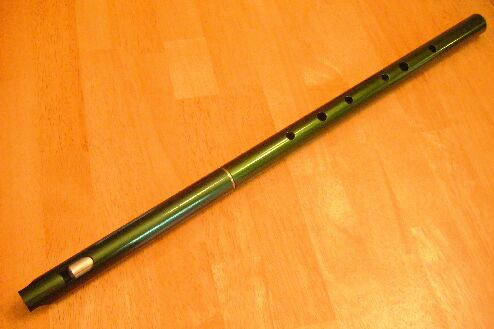
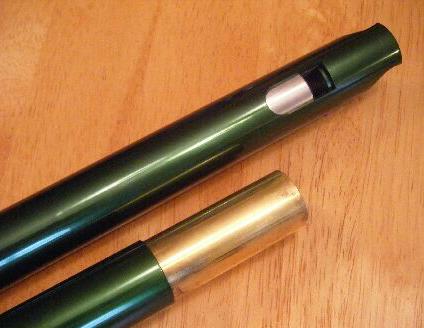
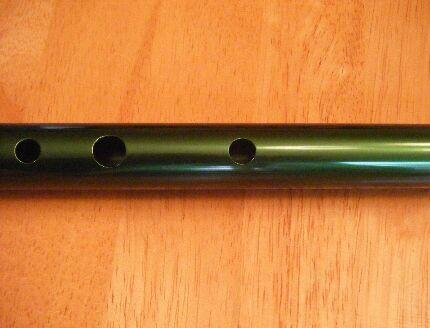
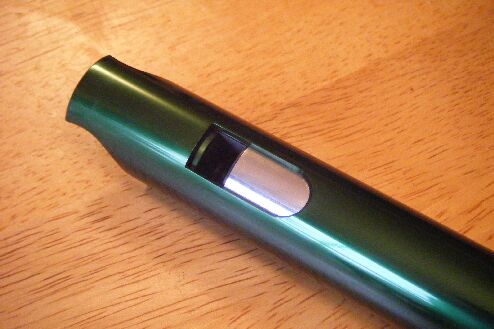
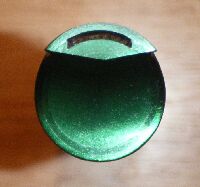


Appearance: At
first glance, words like "slick" and "professional" come to
mind when looking at this whistle. It somehow manages to avoid the
"pipe with holes in it" look while still being, well, a pipe with holes
in it. One of the big reasons for this is the glossy anodized
finish, which I found to be reminiscent of the gloss paint
jobs/finishes you see on cars. This finish gives the somewhat false
impression that the whistle would be slippery to hold, but I found that
as long as my hands were dry, it actually had a nice grip to the
surface, especially when compared to nickeled whistle bodies. The
contrast of the silver blade and brass tuning slide looks striking
against the gloss green of the body (MK's are currently available in
black, red, and green finishes). Indeed, pictures just don't do
this
whistle justice. The mouthpiece is oddly carved with a ridge running
down the middle of the underside. It looked like it would be
uncomfortable, but I did not find it to be so. It actually facilitated
playing the whistle out of the side of ones mouth, but worked just fine
using the standard, straight on position as well. MK's really stand out
from other brands as being very attractive, professional looking
whistles. (my apologies for copying this last paragraph almost verbatim
from my MK low F review, but I couldn't think of a better way to say
the same thing, and hey, if it's not broke...) And for the
aesthetically anal among us (myself included), you might happen to
notice what looks like (and is) a very small dent on the top/front of
the whistle head in one of the pictures. All four of the MK whistles I
have owned have had these small dents in roughly the same place (as
mentioned in the low F review, it was a bit more noticeable on the
first one I had), and I suspect that they must occur somehow in the
manufacturing process.
Tone: Low D's often get compared with flutes in the tone department, but at the end of the day, a low D is a whistle, and should sound like one. After all, if you want to sound like a flute, you should play one! This instrument has a tone that just says Irish whistle, with an excellent blend of breathiness and chiff mixed with a strong/pure yet complex tone. I would say that this whistle has a moderate to high amount of chiff.
Volume: I would describe the volume of this whistle as being moderate to loud in comparison to other Low D's I have played, and it is fairly well balanced between octaves. The top few notes are a little bit louder, but manage to avoid being shrill. The low fundamental is pleasingly full, but even more "note" worthy is that the low E, usually the weakest note on a low D, is also nicely full as well. I'm looking forward to trying this whistle in a session, as I think it might just hold it's own.
Backpressure/air requirement: This whistle has moderate backpressure, with an average air requirement. The high A, B and the low D and E notes do require some attention to ones embouchure, but not overly so, especially when compared to other Low D's. Otherwise the whistle is quite effortless and easy to play.
Responsiveness: This whistle is incredibly responsive, with cuts and rolls virtually exploding under your fingertips. In fact, ornaments pop so quickly I had to slow down the speed I'd been playing them at on other low D's. Mornfull airs really moan and sing on this baby, but at the same time it is more than responsive enough to rip out the fastest reel.
Clogging: This whistle can clog slightly after prolonged play or when cold, but clears easily. I may treat it with duponol which I suspect would completely clear up any further issue. (I suspect that some of my other low D's would probably end up clogging after prolonged play as well, but I wouldn't know as I've never played any of them for as long consecutively as I have this one!)
Tuning: All notes were either spot on or at least within 5 cents of true (which can mostly be blamed on how hard or soft you blow it) with the exception of the second octave D, which was around 5-10 cents sharp, also depending on how hard you blow it. The C natural is right on with the regular OXXOOO fingering, but the OXXXOO, while slightly flat, actually has a nice "darker" tone to it that I quite like.
Sound clip: Eanach Duin
Summary: This whistle just plain does it for me in all departments, and is hands down the best Low D I have played to date. It is amazingly responsive, and has a distinctive, yet intrinsically "whistlely" tone. As such, this MK low D is hereby the first whistle to obtain the highly coveted rank of "six holes". Yes, it really is gods gift to low whistlers!


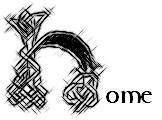
Tone: Low D's often get compared with flutes in the tone department, but at the end of the day, a low D is a whistle, and should sound like one. After all, if you want to sound like a flute, you should play one! This instrument has a tone that just says Irish whistle, with an excellent blend of breathiness and chiff mixed with a strong/pure yet complex tone. I would say that this whistle has a moderate to high amount of chiff.
Volume: I would describe the volume of this whistle as being moderate to loud in comparison to other Low D's I have played, and it is fairly well balanced between octaves. The top few notes are a little bit louder, but manage to avoid being shrill. The low fundamental is pleasingly full, but even more "note" worthy is that the low E, usually the weakest note on a low D, is also nicely full as well. I'm looking forward to trying this whistle in a session, as I think it might just hold it's own.
Backpressure/air requirement: This whistle has moderate backpressure, with an average air requirement. The high A, B and the low D and E notes do require some attention to ones embouchure, but not overly so, especially when compared to other Low D's. Otherwise the whistle is quite effortless and easy to play.
Responsiveness: This whistle is incredibly responsive, with cuts and rolls virtually exploding under your fingertips. In fact, ornaments pop so quickly I had to slow down the speed I'd been playing them at on other low D's. Mornfull airs really moan and sing on this baby, but at the same time it is more than responsive enough to rip out the fastest reel.
Clogging: This whistle can clog slightly after prolonged play or when cold, but clears easily. I may treat it with duponol which I suspect would completely clear up any further issue. (I suspect that some of my other low D's would probably end up clogging after prolonged play as well, but I wouldn't know as I've never played any of them for as long consecutively as I have this one!)
Tuning: All notes were either spot on or at least within 5 cents of true (which can mostly be blamed on how hard or soft you blow it) with the exception of the second octave D, which was around 5-10 cents sharp, also depending on how hard you blow it. The C natural is right on with the regular OXXOOO fingering, but the OXXXOO, while slightly flat, actually has a nice "darker" tone to it that I quite like.
Sound clip: Eanach Duin
Summary: This whistle just plain does it for me in all departments, and is hands down the best Low D I have played to date. It is amazingly responsive, and has a distinctive, yet intrinsically "whistlely" tone. As such, this MK low D is hereby the first whistle to obtain the highly coveted rank of "six holes". Yes, it really is gods gift to low whistlers!
Addendum: As
mentioned in this review and the review of the MK low F, I pointed out
that they had what appeared to be dents on the head of the whistle that
I speculated occurred during the manufacturing process. However, I was
nonplussed to discover two more of these "dents" show up on the whistle
reviewed above, without any impact occuring to the instrument! I
noticed that these dents were all in the same location around where the
female part of the tuning slide joint ended on the inside of the
whistle head. Naturally I shot an email off to Misha Somerville, and he
informed me that this phenomena did occur on earlier models of his
whistles, as the aluminum proved not to be thick enough at that point.
He stated that while unsightly, he was unaware of these dents or
buckles rendering a whistle unplayable or effecting it's tone. He also
assurred me that they had fixed this issue on their newer models. As
the above reviewed whistle is my main go to low D, I decided to order a
new one incase this one ever did structually fail. (as I had purchased
the above low D second hand, it was not covered under any manufacturers
warranty) The head joint on my shiny new black MK low D is noticeably
heavier than on my green one, most likely due to the structural
reinforcement added to correct the above problem. Unfortunatley, while
the whistle still looks, and plays as good as my first green one, the
tone is slightly less open/resonant and a little darker, perhaps also
due to the heavier head. It also seems to have just slightly more
backpressure as well. It is still a great whistle, but my green MK
remains my favorite.